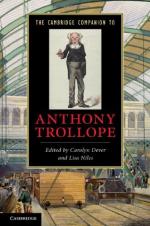|
This section contains 8,384 words (approx. 28 pages at 300 words per page) |

|
SOURCE: “Trollope's Metonymies,” Nineteenth-Century Literature, Vol. 37, No. 3, December, 1982, pp. 272-92.
In the following essay, Riffaterre examines Trollope's use of metonymy, demonstrating that metonymies in Trollope's novels are primarily comic devices used for descriptive purposes. This dual function, Riffaterre states, is typical of the type of contradiction that is one of the hallmarks of Trollope's style.
After a century of criticism, much remains to be said about Trollope's technique. His approach to traditional or perhaps obsolescent concepts of the novel and his morality have been much studied. But relatively little is known of his writing practice other than what he himself revealed in his Autobiography. Indeed there exists no thorough, detailed analysis of the formal and semantic structures of his narrative and descriptive style. As a step in that direction I propose to examine Trollope's use of the descriptive detail in sketching his characters. The function of the detail...
|
This section contains 8,384 words (approx. 28 pages at 300 words per page) |

|


